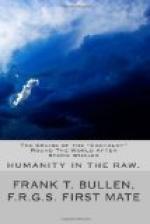Not the least of the minor troubles on board the cachalot was the uncertainty of our destination; we never knew where we were going. It may seem a small point, but it is really not so unimportant as a landsman might imagine. On an ordinary passage, certain well-known signs are as easily read by the seaman as if the ship’s position were given out to him every day. Every alteration of the course signifies some point of the journey reached, some well-known track entered upon, and every landfall made becomes a new departure from whence to base one’s calculations, which, rough as they are, rarely err more than a few days.
Say, for instance, you are bound for Calcutta. The first of the north-east trades will give a fair idea of your latitude being about the edge of the tropics somewhere, or say from 20deg. to 25deg. N., whether you have sighted any of the islands or not. Then away you go before the wind down towards the Equator, the approach to which is notified by the loss of the trade and the dirty, changeable weather of the “doldrums.” That weary bit of work over, along come the south-east trades, making you brace “sharp up,” and sometimes driving you uncomfortably near the Brazilian coast. Presently more “doldrums,” with a good deal more wind in them than in the “wariables” of the line latitude. The brave “westerly” will come along by-and-by and release you, and, with a staggering press of sail carried to the reliable gale, away you go for the long stretch of a hundred degrees or so eastward. You will very likely sight Tristan d’Acunha or Gough lsland; but, if not, the course will keep you fairly well informed of your longitude, since most ships make more or less of a great circle track. Instead of steering due East for the whole distance, they make for some southerly latitude by running along the arc of a great circle, then run due east for a thousand miles or so before gradually working north again. These alterations in the courses tell the foremast hand nearly all he wants to know, slight as they are. You will most probably sight Amsterdam Island or St. Paul’s in about 77deg. E.; but whether you do or not, the big change made in the course, to say nothing of the difference in the weather and temperature, say loudly that your long easterly run is over, and you are bound to the northward again. Soon the south-east trades will take you gently in hand, and waft you pleasurably upward to the line again, unless you should be so unfortunate as to meet one of the devastating meteors known as “cyclones” in its gyration across the Indian Ocean. After losing the trade, which signals your approach to the line once more, your guides fluctuate muchly with the time of year. But it may be broadly put that the change of the monsoon in the Bay of Bengal is beastliness unadulterated, and the south-west monsoon itself, though a fair wind for getting to your destination, is worse, if possible. Still, having got that far, you are able to judge pretty nearly when, in the ordinary course of events, you will arrive at Saugor, and get a tug for the rest of the journey.




